Strategic Management Analysis: Australian Car Manufacturing Industry
VerifiedAdded on 2023/04/12
|10
|1762
|344
Report
AI Summary
This report provides a comprehensive analysis of the car manufacturing industry in Australia, focusing on the factors that led to its decline. It begins with an introduction and background, highlighting the historical context of the industry, including key players like Holden, Ford, and Toyota. The report then applies Porter's Five Forces framework to assess the competitive landscape, examining the bargaining power of suppliers and purchasers, the threat of new entrants and substitutes, and the intensity of rivalry among existing competitors. Furthermore, a PEST analysis is conducted to evaluate the political, economic, socio-cultural, and technological impacts on the industry. The political section discusses government policies and their effects, including subsidies and trade agreements. The economic analysis considers job losses and trade flows. Socio-cultural factors, such as employment and consumer behavior, are also examined. Finally, technological impacts, like the loss of technical expertise, are explored. The report concludes by summarizing the key findings and implications for the industry's future.
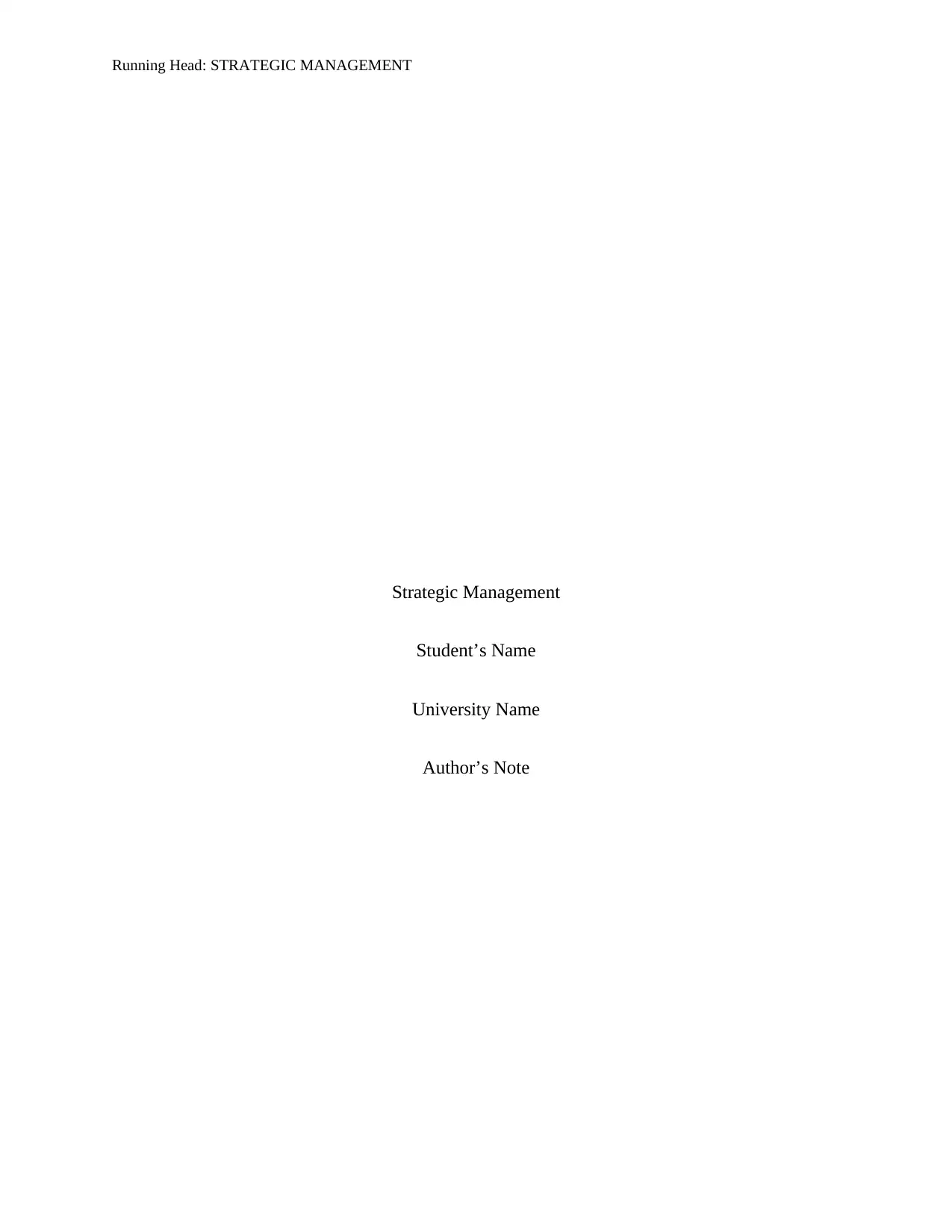
Running Head: STRATEGIC MANAGEMENT
Strategic Management
Student’s Name
University Name
Author’s Note
Strategic Management
Student’s Name
University Name
Author’s Note
Paraphrase This Document
Need a fresh take? Get an instant paraphrase of this document with our AI Paraphraser

2STRATEGIC MANAGEMENT
Table of Contents
1. Introduction..................................................................................................................................3
2. Background of Study...................................................................................................................3
3. Five Forces Analysis....................................................................................................................4
3.1 New Entrants..........................................................................................................................4
3.2 Existing Competitors..............................................................................................................4
3.3 Threats of Substitution...........................................................................................................5
3.4 Bargaining ability of the Purchasers......................................................................................5
3.5 Bargaining power of the Suppliers.........................................................................................5
5. Situational Impact Analysis.........................................................................................................5
5.1 PEST Analysis.......................................................................................................................5
5.1.1 Political Impacts..............................................................................................................5
5.1.2 Economic Impacts...........................................................................................................6
5.1.3 Socio-Cultural Impacts....................................................................................................7
5.1.4 Technological Impacts....................................................................................................7
6. Conclusion...................................................................................................................................7
Reference List..................................................................................................................................9
Table of Contents
1. Introduction..................................................................................................................................3
2. Background of Study...................................................................................................................3
3. Five Forces Analysis....................................................................................................................4
3.1 New Entrants..........................................................................................................................4
3.2 Existing Competitors..............................................................................................................4
3.3 Threats of Substitution...........................................................................................................5
3.4 Bargaining ability of the Purchasers......................................................................................5
3.5 Bargaining power of the Suppliers.........................................................................................5
5. Situational Impact Analysis.........................................................................................................5
5.1 PEST Analysis.......................................................................................................................5
5.1.1 Political Impacts..............................................................................................................5
5.1.2 Economic Impacts...........................................................................................................6
5.1.3 Socio-Cultural Impacts....................................................................................................7
5.1.4 Technological Impacts....................................................................................................7
6. Conclusion...................................................................................................................................7
Reference List..................................................................................................................................9
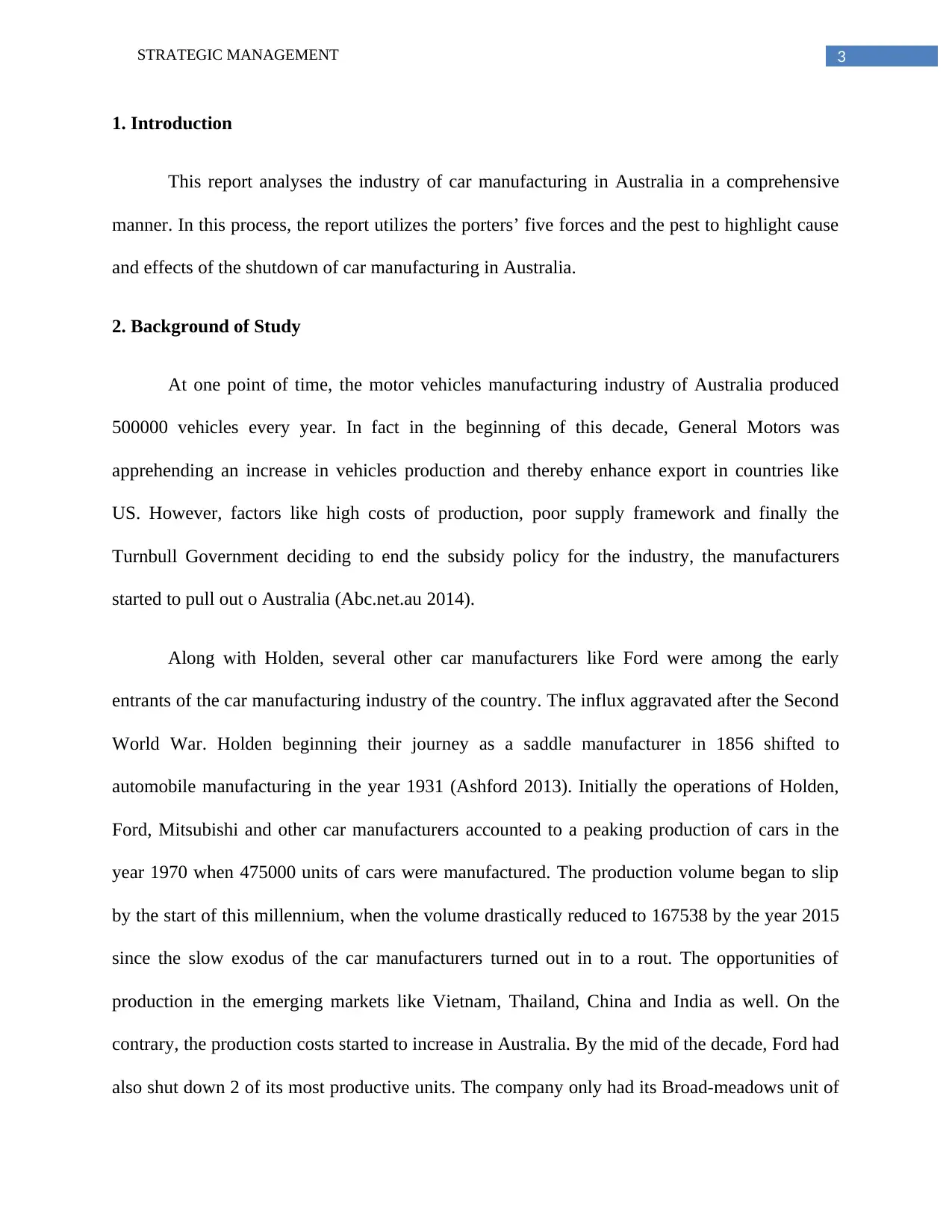
3STRATEGIC MANAGEMENT
1. Introduction
This report analyses the industry of car manufacturing in Australia in a comprehensive
manner. In this process, the report utilizes the porters’ five forces and the pest to highlight cause
and effects of the shutdown of car manufacturing in Australia.
2. Background of Study
At one point of time, the motor vehicles manufacturing industry of Australia produced
500000 vehicles every year. In fact in the beginning of this decade, General Motors was
apprehending an increase in vehicles production and thereby enhance export in countries like
US. However, factors like high costs of production, poor supply framework and finally the
Turnbull Government deciding to end the subsidy policy for the industry, the manufacturers
started to pull out o Australia (Abc.net.au 2014).
Along with Holden, several other car manufacturers like Ford were among the early
entrants of the car manufacturing industry of the country. The influx aggravated after the Second
World War. Holden beginning their journey as a saddle manufacturer in 1856 shifted to
automobile manufacturing in the year 1931 (Ashford 2013). Initially the operations of Holden,
Ford, Mitsubishi and other car manufacturers accounted to a peaking production of cars in the
year 1970 when 475000 units of cars were manufactured. The production volume began to slip
by the start of this millennium, when the volume drastically reduced to 167538 by the year 2015
since the slow exodus of the car manufacturers turned out in to a rout. The opportunities of
production in the emerging markets like Vietnam, Thailand, China and India as well. On the
contrary, the production costs started to increase in Australia. By the mid of the decade, Ford had
also shut down 2 of its most productive units. The company only had its Broad-meadows unit of
1. Introduction
This report analyses the industry of car manufacturing in Australia in a comprehensive
manner. In this process, the report utilizes the porters’ five forces and the pest to highlight cause
and effects of the shutdown of car manufacturing in Australia.
2. Background of Study
At one point of time, the motor vehicles manufacturing industry of Australia produced
500000 vehicles every year. In fact in the beginning of this decade, General Motors was
apprehending an increase in vehicles production and thereby enhance export in countries like
US. However, factors like high costs of production, poor supply framework and finally the
Turnbull Government deciding to end the subsidy policy for the industry, the manufacturers
started to pull out o Australia (Abc.net.au 2014).
Along with Holden, several other car manufacturers like Ford were among the early
entrants of the car manufacturing industry of the country. The influx aggravated after the Second
World War. Holden beginning their journey as a saddle manufacturer in 1856 shifted to
automobile manufacturing in the year 1931 (Ashford 2013). Initially the operations of Holden,
Ford, Mitsubishi and other car manufacturers accounted to a peaking production of cars in the
year 1970 when 475000 units of cars were manufactured. The production volume began to slip
by the start of this millennium, when the volume drastically reduced to 167538 by the year 2015
since the slow exodus of the car manufacturers turned out in to a rout. The opportunities of
production in the emerging markets like Vietnam, Thailand, China and India as well. On the
contrary, the production costs started to increase in Australia. By the mid of the decade, Ford had
also shut down 2 of its most productive units. The company only had its Broad-meadows unit of
⊘ This is a preview!⊘
Do you want full access?
Subscribe today to unlock all pages.

Trusted by 1+ million students worldwide
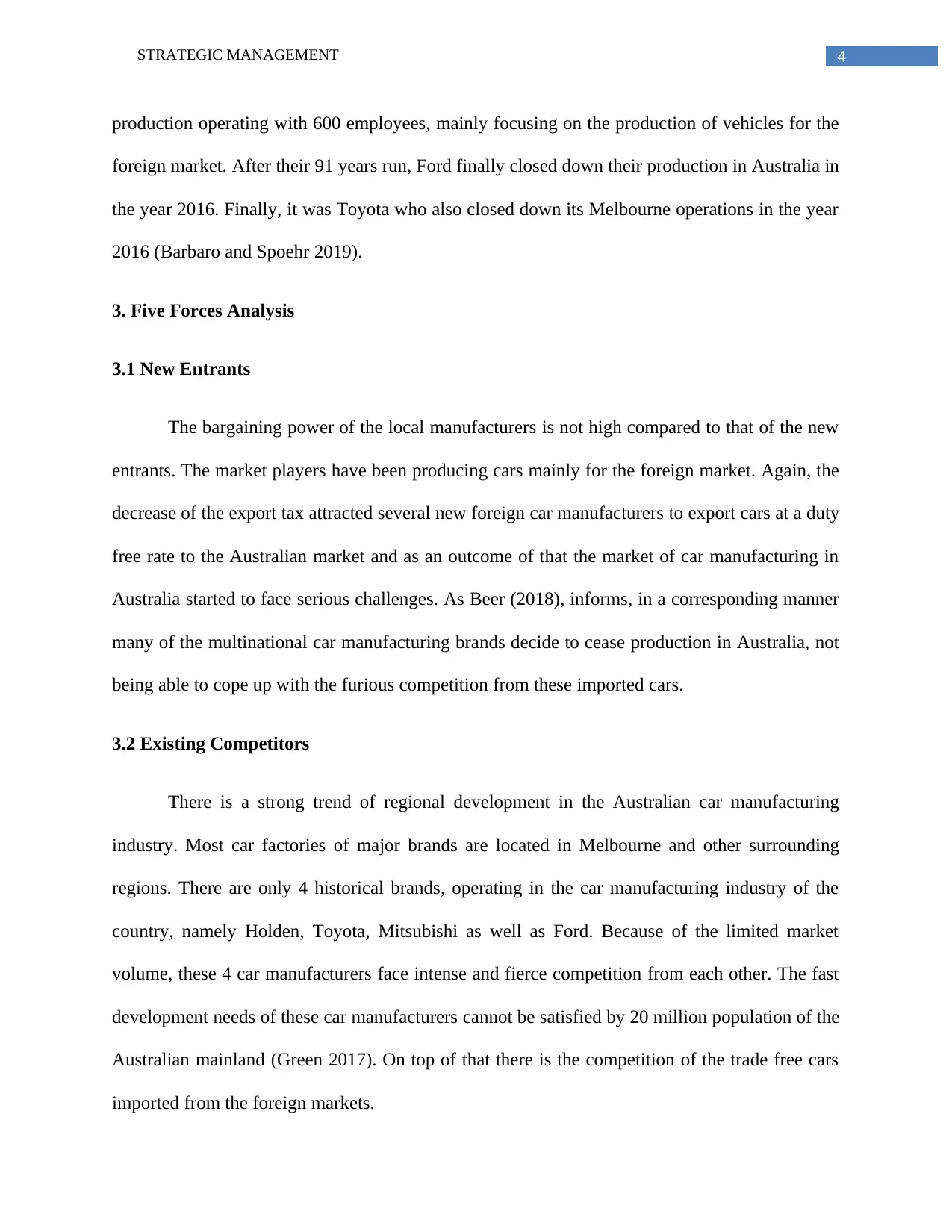
4STRATEGIC MANAGEMENT
production operating with 600 employees, mainly focusing on the production of vehicles for the
foreign market. After their 91 years run, Ford finally closed down their production in Australia in
the year 2016. Finally, it was Toyota who also closed down its Melbourne operations in the year
2016 (Barbaro and Spoehr 2019).
3. Five Forces Analysis
3.1 New Entrants
The bargaining power of the local manufacturers is not high compared to that of the new
entrants. The market players have been producing cars mainly for the foreign market. Again, the
decrease of the export tax attracted several new foreign car manufacturers to export cars at a duty
free rate to the Australian market and as an outcome of that the market of car manufacturing in
Australia started to face serious challenges. As Beer (2018), informs, in a corresponding manner
many of the multinational car manufacturing brands decide to cease production in Australia, not
being able to cope up with the furious competition from these imported cars.
3.2 Existing Competitors
There is a strong trend of regional development in the Australian car manufacturing
industry. Most car factories of major brands are located in Melbourne and other surrounding
regions. There are only 4 historical brands, operating in the car manufacturing industry of the
country, namely Holden, Toyota, Mitsubishi as well as Ford. Because of the limited market
volume, these 4 car manufacturers face intense and fierce competition from each other. The fast
development needs of these car manufacturers cannot be satisfied by 20 million population of the
Australian mainland (Green 2017). On top of that there is the competition of the trade free cars
imported from the foreign markets.
production operating with 600 employees, mainly focusing on the production of vehicles for the
foreign market. After their 91 years run, Ford finally closed down their production in Australia in
the year 2016. Finally, it was Toyota who also closed down its Melbourne operations in the year
2016 (Barbaro and Spoehr 2019).
3. Five Forces Analysis
3.1 New Entrants
The bargaining power of the local manufacturers is not high compared to that of the new
entrants. The market players have been producing cars mainly for the foreign market. Again, the
decrease of the export tax attracted several new foreign car manufacturers to export cars at a duty
free rate to the Australian market and as an outcome of that the market of car manufacturing in
Australia started to face serious challenges. As Beer (2018), informs, in a corresponding manner
many of the multinational car manufacturing brands decide to cease production in Australia, not
being able to cope up with the furious competition from these imported cars.
3.2 Existing Competitors
There is a strong trend of regional development in the Australian car manufacturing
industry. Most car factories of major brands are located in Melbourne and other surrounding
regions. There are only 4 historical brands, operating in the car manufacturing industry of the
country, namely Holden, Toyota, Mitsubishi as well as Ford. Because of the limited market
volume, these 4 car manufacturers face intense and fierce competition from each other. The fast
development needs of these car manufacturers cannot be satisfied by 20 million population of the
Australian mainland (Green 2017). On top of that there is the competition of the trade free cars
imported from the foreign markets.
Paraphrase This Document
Need a fresh take? Get an instant paraphrase of this document with our AI Paraphraser
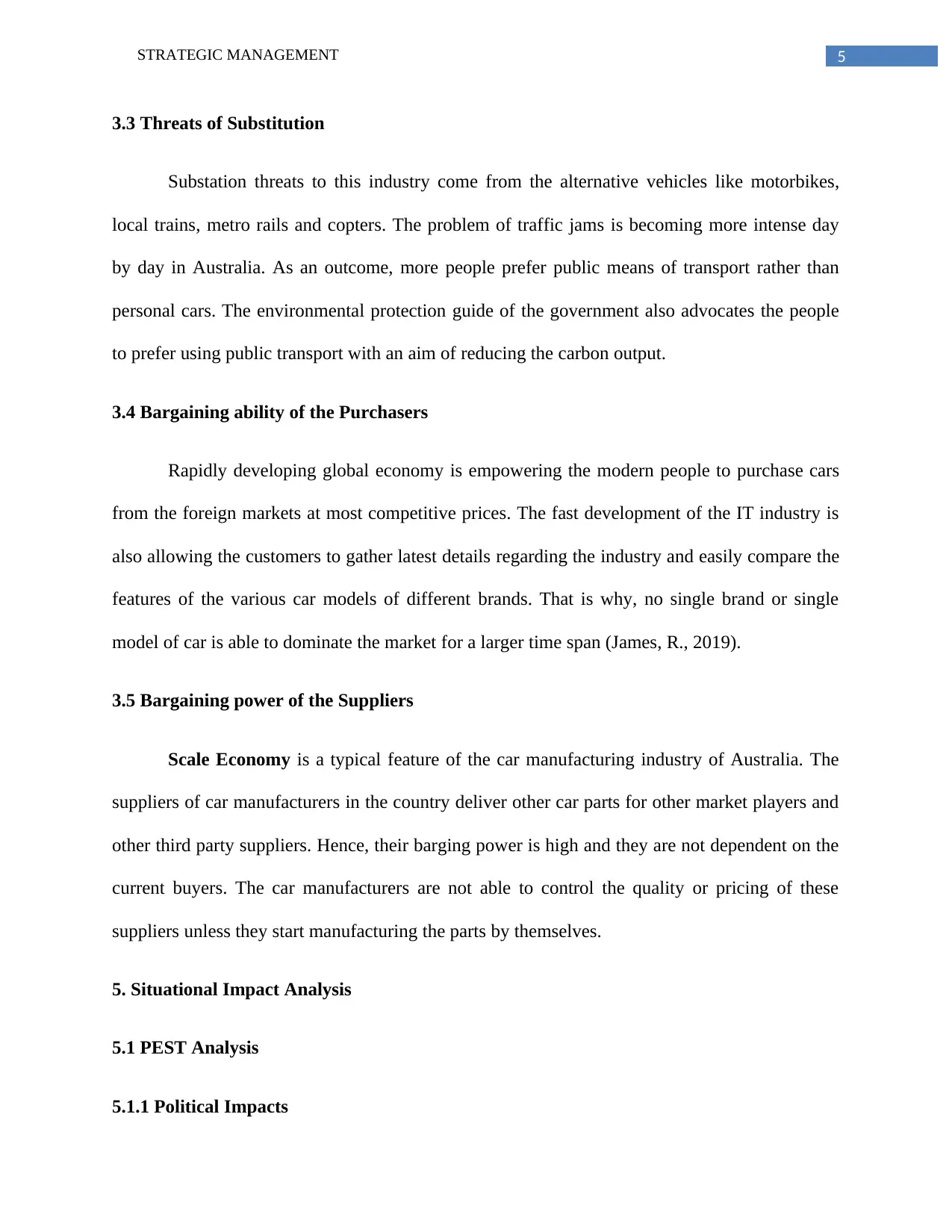
5STRATEGIC MANAGEMENT
3.3 Threats of Substitution
Substation threats to this industry come from the alternative vehicles like motorbikes,
local trains, metro rails and copters. The problem of traffic jams is becoming more intense day
by day in Australia. As an outcome, more people prefer public means of transport rather than
personal cars. The environmental protection guide of the government also advocates the people
to prefer using public transport with an aim of reducing the carbon output.
3.4 Bargaining ability of the Purchasers
Rapidly developing global economy is empowering the modern people to purchase cars
from the foreign markets at most competitive prices. The fast development of the IT industry is
also allowing the customers to gather latest details regarding the industry and easily compare the
features of the various car models of different brands. That is why, no single brand or single
model of car is able to dominate the market for a larger time span (James, R., 2019).
3.5 Bargaining power of the Suppliers
Scale Economy is a typical feature of the car manufacturing industry of Australia. The
suppliers of car manufacturers in the country deliver other car parts for other market players and
other third party suppliers. Hence, their barging power is high and they are not dependent on the
current buyers. The car manufacturers are not able to control the quality or pricing of these
suppliers unless they start manufacturing the parts by themselves.
5. Situational Impact Analysis
5.1 PEST Analysis
5.1.1 Political Impacts
3.3 Threats of Substitution
Substation threats to this industry come from the alternative vehicles like motorbikes,
local trains, metro rails and copters. The problem of traffic jams is becoming more intense day
by day in Australia. As an outcome, more people prefer public means of transport rather than
personal cars. The environmental protection guide of the government also advocates the people
to prefer using public transport with an aim of reducing the carbon output.
3.4 Bargaining ability of the Purchasers
Rapidly developing global economy is empowering the modern people to purchase cars
from the foreign markets at most competitive prices. The fast development of the IT industry is
also allowing the customers to gather latest details regarding the industry and easily compare the
features of the various car models of different brands. That is why, no single brand or single
model of car is able to dominate the market for a larger time span (James, R., 2019).
3.5 Bargaining power of the Suppliers
Scale Economy is a typical feature of the car manufacturing industry of Australia. The
suppliers of car manufacturers in the country deliver other car parts for other market players and
other third party suppliers. Hence, their barging power is high and they are not dependent on the
current buyers. The car manufacturers are not able to control the quality or pricing of these
suppliers unless they start manufacturing the parts by themselves.
5. Situational Impact Analysis
5.1 PEST Analysis
5.1.1 Political Impacts
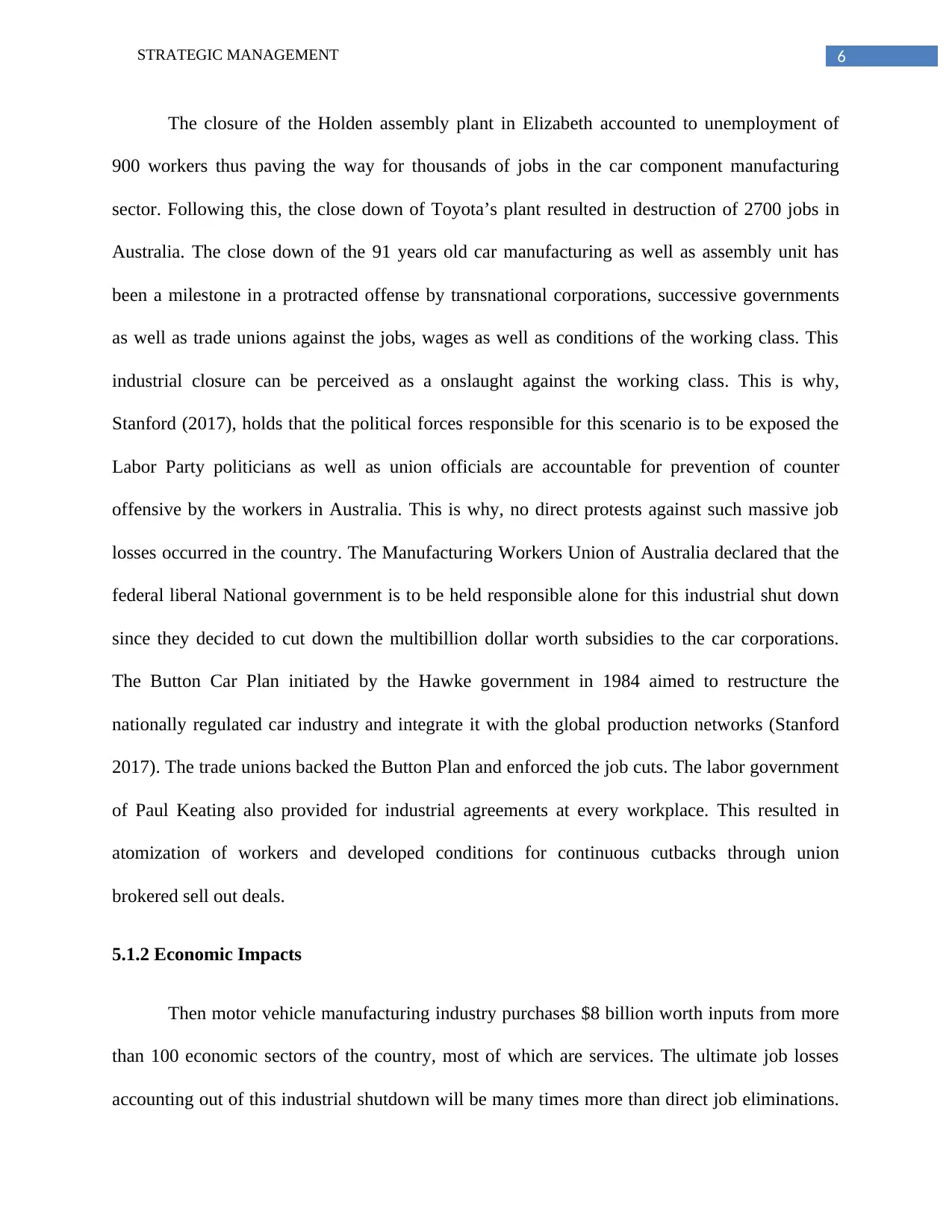
6STRATEGIC MANAGEMENT
The closure of the Holden assembly plant in Elizabeth accounted to unemployment of
900 workers thus paving the way for thousands of jobs in the car component manufacturing
sector. Following this, the close down of Toyota’s plant resulted in destruction of 2700 jobs in
Australia. The close down of the 91 years old car manufacturing as well as assembly unit has
been a milestone in a protracted offense by transnational corporations, successive governments
as well as trade unions against the jobs, wages as well as conditions of the working class. This
industrial closure can be perceived as a onslaught against the working class. This is why,
Stanford (2017), holds that the political forces responsible for this scenario is to be exposed the
Labor Party politicians as well as union officials are accountable for prevention of counter
offensive by the workers in Australia. This is why, no direct protests against such massive job
losses occurred in the country. The Manufacturing Workers Union of Australia declared that the
federal liberal National government is to be held responsible alone for this industrial shut down
since they decided to cut down the multibillion dollar worth subsidies to the car corporations.
The Button Car Plan initiated by the Hawke government in 1984 aimed to restructure the
nationally regulated car industry and integrate it with the global production networks (Stanford
2017). The trade unions backed the Button Plan and enforced the job cuts. The labor government
of Paul Keating also provided for industrial agreements at every workplace. This resulted in
atomization of workers and developed conditions for continuous cutbacks through union
brokered sell out deals.
5.1.2 Economic Impacts
Then motor vehicle manufacturing industry purchases $8 billion worth inputs from more
than 100 economic sectors of the country, most of which are services. The ultimate job losses
accounting out of this industrial shutdown will be many times more than direct job eliminations.
The closure of the Holden assembly plant in Elizabeth accounted to unemployment of
900 workers thus paving the way for thousands of jobs in the car component manufacturing
sector. Following this, the close down of Toyota’s plant resulted in destruction of 2700 jobs in
Australia. The close down of the 91 years old car manufacturing as well as assembly unit has
been a milestone in a protracted offense by transnational corporations, successive governments
as well as trade unions against the jobs, wages as well as conditions of the working class. This
industrial closure can be perceived as a onslaught against the working class. This is why,
Stanford (2017), holds that the political forces responsible for this scenario is to be exposed the
Labor Party politicians as well as union officials are accountable for prevention of counter
offensive by the workers in Australia. This is why, no direct protests against such massive job
losses occurred in the country. The Manufacturing Workers Union of Australia declared that the
federal liberal National government is to be held responsible alone for this industrial shut down
since they decided to cut down the multibillion dollar worth subsidies to the car corporations.
The Button Car Plan initiated by the Hawke government in 1984 aimed to restructure the
nationally regulated car industry and integrate it with the global production networks (Stanford
2017). The trade unions backed the Button Plan and enforced the job cuts. The labor government
of Paul Keating also provided for industrial agreements at every workplace. This resulted in
atomization of workers and developed conditions for continuous cutbacks through union
brokered sell out deals.
5.1.2 Economic Impacts
Then motor vehicle manufacturing industry purchases $8 billion worth inputs from more
than 100 economic sectors of the country, most of which are services. The ultimate job losses
accounting out of this industrial shutdown will be many times more than direct job eliminations.
⊘ This is a preview!⊘
Do you want full access?
Subscribe today to unlock all pages.

Trusted by 1+ million students worldwide

7STRATEGIC MANAGEMENT
The enactment of five free trade deals with the automotive producing nations like USA, South
Korea, China, Thailand and Japan provided the global manufacturers with free tickets to sell
their vehicles in the market of Australian mainland. This disrupted the trade flows and the
demand for output of the 4 major brands reduced heavily.
5.1.3 Socio-Cultural Impacts
Media reports reveal that Toyota, Holden along with Ford is jointly accountable for
employment of 8000 people of the vehicle industry. Hence the joint close down also brought
about a disastrous impact. The car industry is the biggest in terms of state employment. However
after the job losses, Valadkhani, A. and Smyth (2016), informs that 75% of the affected people
did not receive alternative employment. The decrement of the taxpayer will also be accountable
for reducing the cost of vehicles in Australia also.
5.1.4 Technological Impacts
After the major companies like Ford, Holden and Toyota exits the industry, there will be
a vacuum created for 260 businesses that supplies accessories as well as components to the
Automotive sector of Australia. The industry used to accept and provide services in domains like
scientific research, engineering and so on. Scientists in this sector includes CSIRO staff were
mainly involved in R&D activities. The car manufacturing companies also used to provide
technical support, transferrable skills as well as engineering employee training to the small scale
suppliers they accounted for extensive technical knowledge spillovers from this sector to other
industries. After the exit of these companies the car design base of Australia is going to be
reasonably shrunken.
6. Conclusion
The enactment of five free trade deals with the automotive producing nations like USA, South
Korea, China, Thailand and Japan provided the global manufacturers with free tickets to sell
their vehicles in the market of Australian mainland. This disrupted the trade flows and the
demand for output of the 4 major brands reduced heavily.
5.1.3 Socio-Cultural Impacts
Media reports reveal that Toyota, Holden along with Ford is jointly accountable for
employment of 8000 people of the vehicle industry. Hence the joint close down also brought
about a disastrous impact. The car industry is the biggest in terms of state employment. However
after the job losses, Valadkhani, A. and Smyth (2016), informs that 75% of the affected people
did not receive alternative employment. The decrement of the taxpayer will also be accountable
for reducing the cost of vehicles in Australia also.
5.1.4 Technological Impacts
After the major companies like Ford, Holden and Toyota exits the industry, there will be
a vacuum created for 260 businesses that supplies accessories as well as components to the
Automotive sector of Australia. The industry used to accept and provide services in domains like
scientific research, engineering and so on. Scientists in this sector includes CSIRO staff were
mainly involved in R&D activities. The car manufacturing companies also used to provide
technical support, transferrable skills as well as engineering employee training to the small scale
suppliers they accounted for extensive technical knowledge spillovers from this sector to other
industries. After the exit of these companies the car design base of Australia is going to be
reasonably shrunken.
6. Conclusion
Paraphrase This Document
Need a fresh take? Get an instant paraphrase of this document with our AI Paraphraser
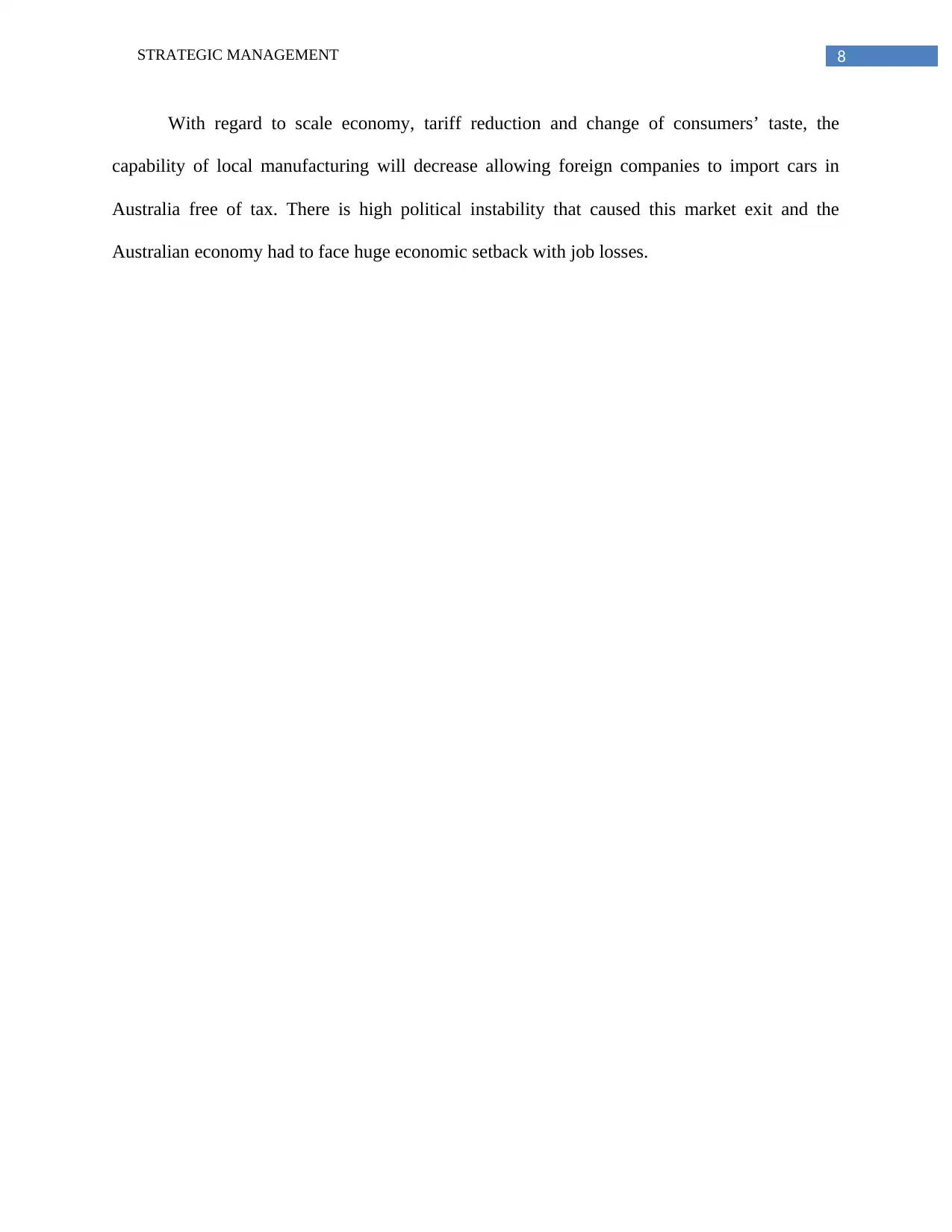
8STRATEGIC MANAGEMENT
With regard to scale economy, tariff reduction and change of consumers’ taste, the
capability of local manufacturing will decrease allowing foreign companies to import cars in
Australia free of tax. There is high political instability that caused this market exit and the
Australian economy had to face huge economic setback with job losses.
With regard to scale economy, tariff reduction and change of consumers’ taste, the
capability of local manufacturing will decrease allowing foreign companies to import cars in
Australia free of tax. There is high political instability that caused this market exit and the
Australian economy had to face huge economic setback with job losses.
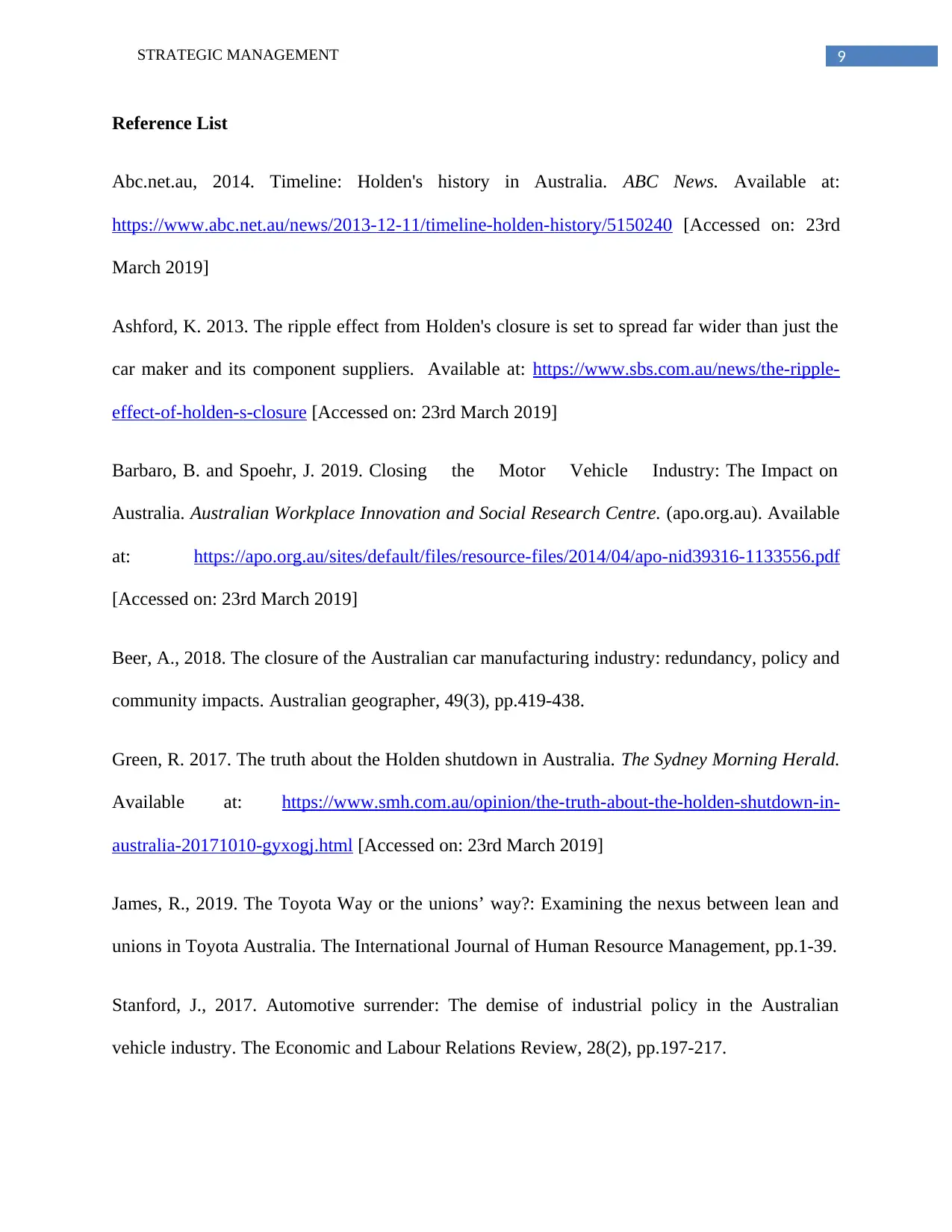
9STRATEGIC MANAGEMENT
Reference List
Abc.net.au, 2014. Timeline: Holden's history in Australia. ABC News. Available at:
https://www.abc.net.au/news/2013-12-11/timeline-holden-history/5150240 [Accessed on: 23rd
March 2019]
Ashford, K. 2013. The ripple effect from Holden's closure is set to spread far wider than just the
car maker and its component suppliers. Available at: https://www.sbs.com.au/news/the-ripple-
effect-of-holden-s-closure [Accessed on: 23rd March 2019]
Barbaro, B. and Spoehr, J. 2019. Closing the Motor Vehicle Industry: The Impact on
Australia. Australian Workplace Innovation and Social Research Centre. (apo.org.au). Available
at: https://apo.org.au/sites/default/files/resource-files/2014/04/apo-nid39316-1133556.pdf
[Accessed on: 23rd March 2019]
Beer, A., 2018. The closure of the Australian car manufacturing industry: redundancy, policy and
community impacts. Australian geographer, 49(3), pp.419-438.
Green, R. 2017. The truth about the Holden shutdown in Australia. The Sydney Morning Herald.
Available at: https://www.smh.com.au/opinion/the-truth-about-the-holden-shutdown-in-
australia-20171010-gyxogj.html [Accessed on: 23rd March 2019]
James, R., 2019. The Toyota Way or the unions’ way?: Examining the nexus between lean and
unions in Toyota Australia. The International Journal of Human Resource Management, pp.1-39.
Stanford, J., 2017. Automotive surrender: The demise of industrial policy in the Australian
vehicle industry. The Economic and Labour Relations Review, 28(2), pp.197-217.
Reference List
Abc.net.au, 2014. Timeline: Holden's history in Australia. ABC News. Available at:
https://www.abc.net.au/news/2013-12-11/timeline-holden-history/5150240 [Accessed on: 23rd
March 2019]
Ashford, K. 2013. The ripple effect from Holden's closure is set to spread far wider than just the
car maker and its component suppliers. Available at: https://www.sbs.com.au/news/the-ripple-
effect-of-holden-s-closure [Accessed on: 23rd March 2019]
Barbaro, B. and Spoehr, J. 2019. Closing the Motor Vehicle Industry: The Impact on
Australia. Australian Workplace Innovation and Social Research Centre. (apo.org.au). Available
at: https://apo.org.au/sites/default/files/resource-files/2014/04/apo-nid39316-1133556.pdf
[Accessed on: 23rd March 2019]
Beer, A., 2018. The closure of the Australian car manufacturing industry: redundancy, policy and
community impacts. Australian geographer, 49(3), pp.419-438.
Green, R. 2017. The truth about the Holden shutdown in Australia. The Sydney Morning Herald.
Available at: https://www.smh.com.au/opinion/the-truth-about-the-holden-shutdown-in-
australia-20171010-gyxogj.html [Accessed on: 23rd March 2019]
James, R., 2019. The Toyota Way or the unions’ way?: Examining the nexus between lean and
unions in Toyota Australia. The International Journal of Human Resource Management, pp.1-39.
Stanford, J., 2017. Automotive surrender: The demise of industrial policy in the Australian
vehicle industry. The Economic and Labour Relations Review, 28(2), pp.197-217.
⊘ This is a preview!⊘
Do you want full access?
Subscribe today to unlock all pages.

Trusted by 1+ million students worldwide
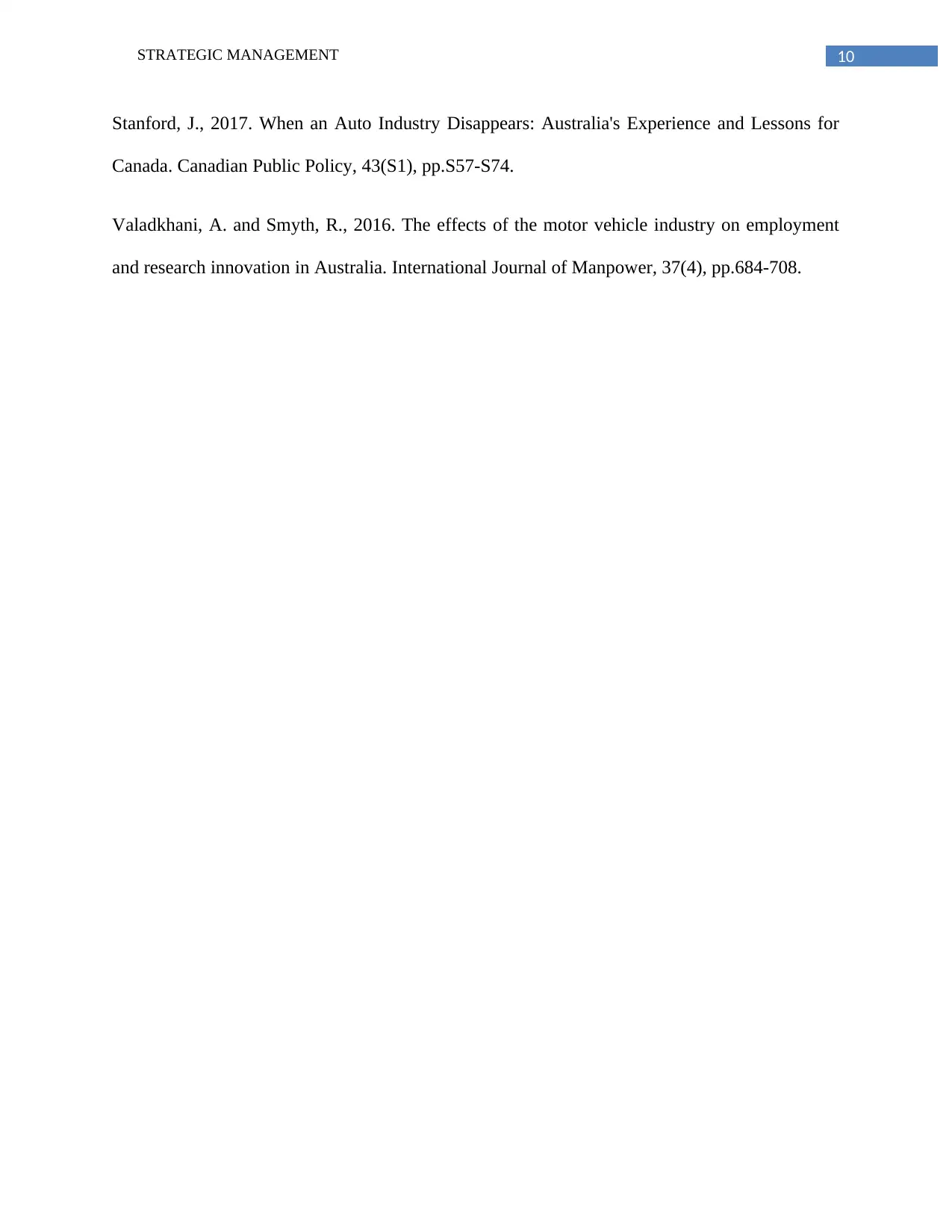
10STRATEGIC MANAGEMENT
Stanford, J., 2017. When an Auto Industry Disappears: Australia's Experience and Lessons for
Canada. Canadian Public Policy, 43(S1), pp.S57-S74.
Valadkhani, A. and Smyth, R., 2016. The effects of the motor vehicle industry on employment
and research innovation in Australia. International Journal of Manpower, 37(4), pp.684-708.
Stanford, J., 2017. When an Auto Industry Disappears: Australia's Experience and Lessons for
Canada. Canadian Public Policy, 43(S1), pp.S57-S74.
Valadkhani, A. and Smyth, R., 2016. The effects of the motor vehicle industry on employment
and research innovation in Australia. International Journal of Manpower, 37(4), pp.684-708.
1 out of 10
Related Documents
Your All-in-One AI-Powered Toolkit for Academic Success.
+13062052269
info@desklib.com
Available 24*7 on WhatsApp / Email
![[object Object]](/_next/static/media/star-bottom.7253800d.svg)
Unlock your academic potential
Copyright © 2020–2025 A2Z Services. All Rights Reserved. Developed and managed by ZUCOL.





